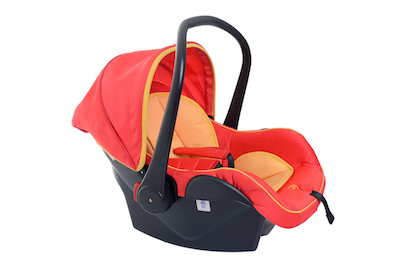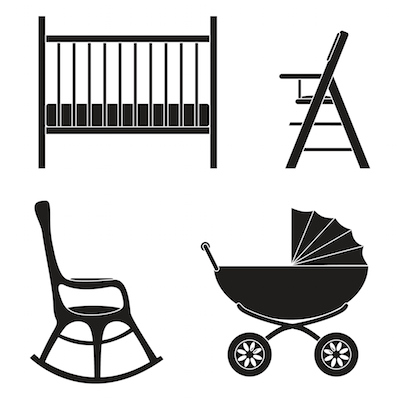Injuries from nursery products are on the rise. Find out how to keep your baby safe.
I remember a time nearly 8 years ago when I was preparing for the birth of my first child and a friend gave me a sleep wedge as a gift. I’d never heard of a sleep wedge, but she said a friend told her it was a lifesaver for getting a baby to sleep.
When I received the gift, I was incredibly thankful for this product that would be helpful once the baby came. But then I started wondering why I’d never seen anything like this mentioned in the newborn parenting books I’d read. As it turns out, pediatricians don’t recommend using a sleep wedge at all. Lots of data on safe sleep for babies tells us that babies should sleep on their back, have a firm fitted mattress, no blankets or soft bedding and nothing else at all in the crib with them.
I was shocked that this product was sitting on store shelves with really convincing marketing that made me believe it was not only safe for my baby, but helpful and maybe even necessary. In my naivete´ I had assumed that if something wasn’t safe for my baby, it wouldn’t even be available for me to buy.
This was the first in a long line of realizations that there are thousands upon thousands of baby products for me to spend my money on, all marketed to make me feel as if they were the answer to all my problems, but that aren’t necessarily safe for my child or recommended by experts.
Injuries from baby products are on the rise
 Products such as cribs, strollers, high chairs, baby carriers, bathtubs, play yards and baby seats are supposed to help make raising kids easier. Lightweight strollers that fold easily into the car and baby swings that lull a child to sleep can feel like lifesavers, and they often do make some aspects of parenting easier than they used to be.
Products such as cribs, strollers, high chairs, baby carriers, bathtubs, play yards and baby seats are supposed to help make raising kids easier. Lightweight strollers that fold easily into the car and baby swings that lull a child to sleep can feel like lifesavers, and they often do make some aspects of parenting easier than they used to be.
A recent study shows, though, that injuries sustained while using common nursery products have increased since 2003. While nursery gadgets can make life easier, they can also cause harm if they are unsafe. From 2009 to 2012, nursery products were the leading category of recalled children’s products in the U.S., yet about 80% of recalled products remain in consumers’ homes. We often aren’t even aware that the product we are using to care for our baby has been deemed unsafe for use.
Even if the product hasn’t been recalled for safety issues, it still can be dangerous for a child. Remember those baby walkers that used to be so popular in the ‘80s? You can hardly find them now. That’s because so many children sustained injuries from them that their use fell out of favor. Lots and lots of kids got hurt, though, before they disappeared from store shelves.
Baby carriers, cribs and mattresses, and strollers cause most injuries
The study mentioned above demonstrates that the most common products associated with injuries are baby carriers (such as detachable car seats), cribs and mattresses, and strollers. Nearly 90% of injuries happened at home, and 80% of injuries were due to a fall.
 Baby carriers can result in injury if the caregiver trips and falls or drops the carrier while baby is inside. We may not be able to prevent all unforeseen accidents such as this, but falls also happen when parents place the carrier on a table or other high surface. Baby carriers placed on soft surfaces such as bedding can also become hazardous; they may tip over and cause suffocation.
Baby carriers can result in injury if the caregiver trips and falls or drops the carrier while baby is inside. We may not be able to prevent all unforeseen accidents such as this, but falls also happen when parents place the carrier on a table or other high surface. Baby carriers placed on soft surfaces such as bedding can also become hazardous; they may tip over and cause suffocation.
The type of crib and mattress you choose for your baby is also an important consideration. Improper bedding can increase the likelihood of Sudden Infant Death Syndrome (read more about that, here). Pediatricians recommend firm mattresses that fit snugly into the crib. No crib bumpers, soft bedding, pillows, blankets or stuffed animals should be in the crib. Dropside cribs are not recommended.
Stroller injuries occur mostly due to tip-overs and falls. This can result from heavy items hanging on the stroller, children playing on or near the stroller or taking a stroller up or down a staircase, among other things. One of the best ways to protect a child from a stroller injury is to be sure they are strapped in securely each and every time the product is used. If a fall or tip-over does occur, the likelihood of injury will be significantly lower.
How you can keep your baby safe
Although we can’t account for every single thing that could happen to a child, there are a few key pieces of wisdom you should consider as you purchase and use nursery products for your baby:
- Ask your doctor’s advice before purchasing nursery products.
While advice from friends and family is sometimes helpful, don’t rely solely on their input when making decisions about your baby’s health and well-being. Ask the expert: your pediatrician. Your doctor has probably seen or heard of every baby gadget out there and the injuries that come along with them- put his or her knowledge to work for you!
- Register the product with the manufacturer so you’ll be notified of a recall.
It only takes a few minutes, but most of us never take the time to register our products. When it comes to our baby, though, it may be worth it to mail in the registration form so you’ll be informed if a problem is identified with a product in your home. Major safety items like the crib, stroller and car seat are worth the time and effort. You can also look up these products with the Consumer Product Safety Commission for recalls and safety alerts.
- Read the manual for each baby product and use the item according to those directions.
Many injuries can be prevented by simple awareness of how the product should and should not be used. Manufacturers of baby carrier seats will tell you not to place the seat on a high surface or a soft surface. Makers of baby strollers will tell you that the stroller may tip over if too much weight is hung on the side of the stroller. Nothing can take the place of adult supervision and proper usage of the product.
- Any baby product that comes with a strap or safety harness should be used each and every time
It’s easy to get complacent. We strap babies into car seats, swings, highchairs and any number of things over and over again throughout a given day. It’s easy to think that if nothing bad has happened before that it likely won’t happen in the short time you leave baby unbuckled for whatever reason. However, the thousands of visitors to emergency departments each year will attest that something can happen in those few seconds or minutes that you leave baby unbuckled. If a product has a safety strap, use it. Every time.
Navigating the immense world of nursery products isn’t easy, but remember this- just because you can buy it, doesn’t mean you should buy it. Let your pediatrician help you sift through the marketing and nonsense to help you choose items that are safe for your baby so you can minimize any chance of your baby being harmed.







